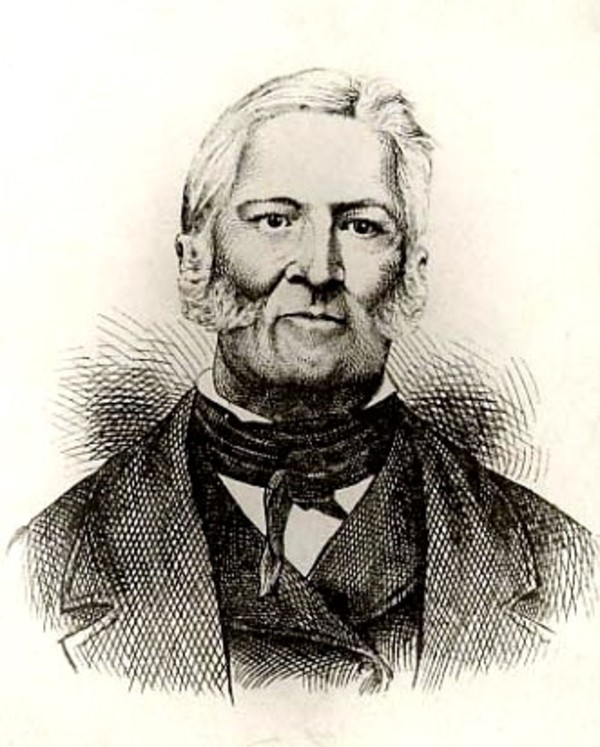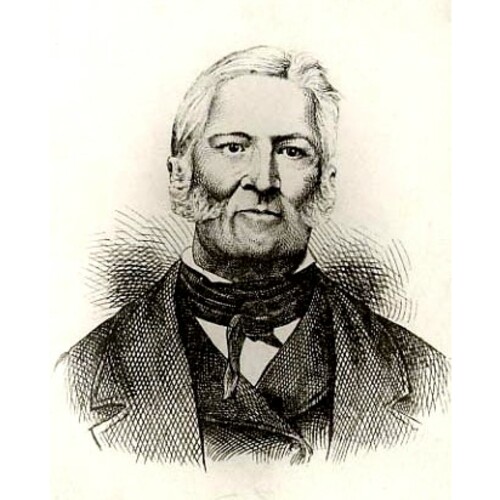
Source: Courtesy of Wikimedia Commons
FARIBAULT, JEAN-BAPTISTE, fur trader, militia officer, office holder, and farmer; b. 19 Oct. 1775 in Berthier-en-Haut (Berthierville), Que., son of Barthélemy Faribault* and Catherine-Antoine Véronneau; d. 20 Aug. 1860 in Faribault, Minn.
The son of a notary, Jean-Baptiste Faribault did not pursue his father’s profession, although three of his brothers, including Joseph-Édouard, did so. Instead, at the age of 16 he left school to take employment as a clerk in one of the commercial houses at Quebec. After two years with a certain Monsieur Thurseau, he was engaged by a second firm, probably that of brothers John and Mathew Macnider which conducted a retail trade on Rue de la Fabrique. Like many young men, Faribault was restless and longed for adventure, and much to the dismay of his family and friends he often talked of becoming a sailor. Family pressure kept him from accepting a commission in the 7th Foot, stationed at Quebec from 1791 to 1793. Prince Edward* Augustus, fourth son of George III and commanding officer of the regiment, had been pleased with some sketches Faribault had made of his troops and had apparently invited him to enlist. In 1798, despite his family’s objections, Faribault left for Fort Michilimackinac (Mackinac Island, Mich.) to enter the fur trade. He was probably in the employ of the Montreal firm of Parker, Gerrard, and Ogilvy [see Samuel Gerrard; John Ogilvy*], whose representative, George Gillespie*, was Faribault’s agent at Michilimackinac. Faribault obtained a permit to trade in the American Northwest Territory from the territorial secretary, William Henry Harrison, and spent the winter of 1798–99 at Kankakee (Ill.). During the following two seasons he traded among the Sioux on the Des Moines River, and in 1802, after mastering the Sioux language, he was placed in charge of the post at Little Rapids on the St Peter (Minnesota) River. While at this post, he took Pelagie Hince, daughter of Joseph Hince (Hanse), as his country wife. The marriage was formalized on 30 April 1817 at St Gabriel’s, a Roman Catholic church in Prairie du Chien (Wis.); the couple were to have eight children.
In 1809 Faribault severed his ties with the Montreal traders, now united under the North West Company, and began trading for furs on his own account at Prairie du Chien. He also traded in lead, buying the mineral from Julien Dubuque and selling it in St Louis (Mo.). At the outbreak of the War of 1812 the inhabitants of Prairie du Chien, the vast majority of whom were French Canadians, remained loyal to Great Britain. Sir George Prevost*, governor of the Canadas and commander in chief of the British forces, placed the defence of the region under the direction of Robert Dickson*, deputy superintendent of the Indian Department. Away from the village when American troops captured the settlement in June 1814, Faribault refused to join the force led by William McKay* which was sent to regain control and he claimed to have been held prisoner by Captain Thomas Gummersall Anderson*. Although Prairie du Chien was easily retaken by McKay’s troops, the area none the less reverted to the United States by the terms of the peace settlement signed at Ghent (Belgium) on 24 Dec. 1814. After the war Faribault became an American citizen and served as militia officer and coroner while rebuilding his fortunes at Prairie du Chien.
By 1819, when Colonel Henry Leavenworth passed through Prairie du Chien on his way west to establish a military installation among the Sioux, the town was losing its importance as a trading centre. Leavenworth learned of Faribault’s ability to deal with the Indians and urged him to open a trading post near the projected fort. Faribault left Prairie du Chien to join Leavenworth in the fall of 1819 and helped to negotiate the 1821 treaty by which the Sioux sold the land needed for the military reservation, Fort Snelling (St Paul, Minn.), completed in 1823. This treaty also gave Pike’s Island, at the confluence of the St Peter and Mississippi rivers, to Faribault’s wife. Although the treaty was signed, it was never ratified by the United States Senate, leaving ownership of the land in doubt. In 1822 the military took possession after Faribault was driven off the island by a flood, and he was unsuccessful in his attempts to gain compensation for the loss of this land. Another flood four years later destroyed his home on the banks of St Peter River, so Faribault moved to the village of St Peter’s (Mendota, Minn.); for many years he farmed there during the summer and traded in furs at Little Rapids during the winter. While at Little Rapids in 1833 he was stabbed in the chest by an Indian to whom he had refused credit. He never fully recovered from this wound.
Faribault remained active in the fur trade, doing business with the American Fur Company, until 1853, when he retired to Faribault, the town founded by his son Alexander as a fur-trading post in 1826. He died there in 1860 at the home of his daughter Emily. Faribault had been a successful trader and later in life settled down as one of Minnesota’s earliest farmers. Respected by his neighbours, he had been elected periodically to minor public offices in Prairie du Chien and Mendota. It was in part through his influence that the United States had been able to negotiate treaties in 1821, 1841, and 1851 with the Indians of the upper Mississippi by which they gave up much of their land. Faribault’s home in Mendota, built in 1837, has been reconstructed as a historic site.
AP, La Visitation (Berthierville), Reg. des baptêmes, mariages et sépultures, 29 oct. 1775. Minn. Hist. Soc. (St Paul), Alexis Bailly papers; H. H. Sibley papers; Stephen Jewett, “After eighty-four years” (1910). Wis., State Hist. Soc. (Madison), Platteville mss V, 1; P. L. Scanlan papers. “Prairie du Chien documents, 1814–’15,” Wis., State Hist. Soc., Coll., 9 (1882): 262–65. The territorial papers of United States, comp. C. E. Carter and J. P. Bloom (28v. to date, Washington, 1934– ; vols.1–26 repr. in 25v., New York, 1973), 28: 160–61, 303–5. DAB. Tanguay, Dictionnaire, 4: 9. W. W. Folwell, A history of Minnesota (4v., St Paul, 1921–30), 1. Joseph Tassé, Les canadiens de l’Ouest (2v., Montréal, 1878), 1: 310–31. H. H. Sibley, “Memoir of Jean Baptiste Faribault,” Minn. Hist. Soc., Coll. (St Paul), 3 (1880): 168–79.
Cite This Article
Paul Trap, “FARIBAULT, JEAN-BAPTISTE,” in Dictionary of Canadian Biography, vol. 8, University of Toronto/Université Laval, 2003–, accessed December 31, 2025, https://www.biographi.ca/en/bio/faribault_jean_baptiste_8E.html.
The citation above shows the format for footnotes and endnotes according to the Chicago manual of style (16th edition). Information to be used in other citation formats:
| Permalink: | https://www.biographi.ca/en/bio/faribault_jean_baptiste_8E.html |
| Author of Article: | Paul Trap |
| Title of Article: | FARIBAULT, JEAN-BAPTISTE |
| Publication Name: | Dictionary of Canadian Biography, vol. 8 |
| Publisher: | University of Toronto/Université Laval |
| Year of publication: | 1985 |
| Year of revision: | 1985 |
| Access Date: | December 31, 2025 |



